

GuidetoAnnotating. Zimmerman How to Annotate. Social Bookmarking Explained by Common Craft. It's just too much.
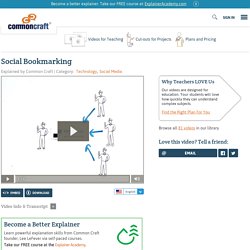
Did you know that there are over 15 billion web pages? To make sense of it all, we need to pluck out the best pages and save them for later. Wikis Explained by Common Craft. These four friends are going on a camping trip.

They need to bring the right supplies because they're backpacking. The group needs to plan and plan well, so coordination is key. They're all computer users, so they start planning with an email. It's start with one, but then becomes a barrage. Email is not good at coordinating and organizing a group's input. This I Believe Essay-Writing Guidelines. We invite you to participate in this project by writing your own statement of personal belief.
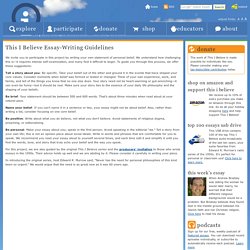
We understand how challenging this is—it requires intense self-examination, and many find it difficult to begin. To guide you through this process, we offer these suggestions: Tell a story about you: Be specific. Take your belief out of the ether and ground it in the events that have shaped your core values. Consider moments when belief was formed or tested or changed. Booth_CraftofResearch3rd. Digital Literacy Explained by Common Craft (VIDEO) Imagine for a moment what it’s like not knowing how to read or write.
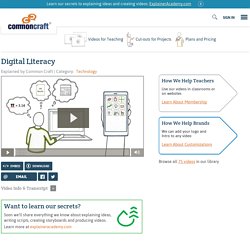
The world becomes much more difficult to navigate and understand. While people around you use written words to apply for jobs and follow instructions, you can’t understand or communicate as well, and this can prevent you from succeeding. Literacy matters. Apps Explained by Common Craft. The chances are you’ve been using apps for years.
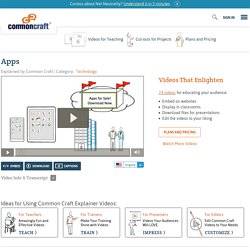
Wikipedia Explained by Common Craft. You've probably seen encyclopedias.

Whether you're settling an argument or researching a school project, these books can hold the answers. These days though, the world moves so fast, it's hard for books that were written months or years ago to keep up. Thankfully we have a new kind of encyclopedia that's online, free, built by thousands of people and changes every day. The idea that thousands of volunteers could create an online encyclopedia doesn't sound possible, but thanks to new technology and specific policies, Wikipedia has become one the top 5 sites on the Web. The site is run by a not-for-profit foundation with a goal to provide everyone on the planet access to the sum of all human knowledge. To see how it works, let's get started with the "wiki" in Wikipedia. Being a wiki means that Wikipedia is always changing. This means every change to Wikipedia is reviewed and must abide by two big rules: The first is verifiability, which is necessary to ensure high quality.
Libraries in the Internet Age Explained by Common Craft. When you think of libraries, you probably picture shelves of books, librarians and kids working on homework.
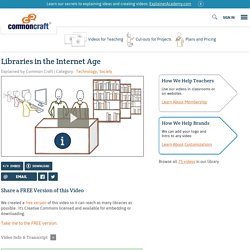
But today, libraries and librarians are a doing a lot more than you might think. You see, libraries are not only about books. The real focus of every library is information. For most of their history, that information lived in books, magazines and periodicals. So libraries and librarians became experts at organizing and understanding how to get the right information out of these resources. This is still the case today, but things are changing quickly. Unfortunately, more isn’t always better. That’s why libraries matter now more than ever. Today librarians are still amazing book-finders - but they are also teachers and technologists. Librarians work to help communities and students become more digitally literate. Today many libraries have comprehensive websites that allow you to access resources like research databases that would be difficult to access otherwise. Plagiarism Explained by Common Craft. You have something in common with the smartest people in the world.
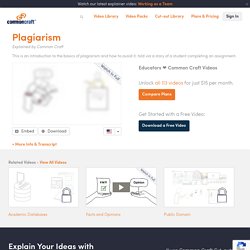
You see, everyone has ideas. We use our minds to create something original, whether it’s a poem, a drawing, a song, or a scientific paper. Some of the most important ideas are published and make it into books, journals, newspapers and trustworthy websites that become the building blocks for things we all learn. But ideas are also very personal, and we need dependable ways to keep track of the people behind the ideas we use because they deserve credit for their contribution, just as you do if someone uses your idea.
Passing off another person’s ideas or words as your own, without credit, is called plagiarism. Meet Cassie, a university student. She’s not the kind of person who would plagiarize by turning in someone else’s work, but she is aware that plagiarism can happen accidentally, so she follows some basic rules: Primary and Secondary Sources Explained by Common Craft. Way back in 1703, a massive storm hit the southern coast of England.

It was a hurricane known as the Great Storm and it took over 8,000 lives. Today we know quite a bit about that storm and what actually happened when it came ashore. We know so much because we have a reliable way to research and document events, places, and people who matter. Using two major kinds of sources, we can establish the facts and information that represent the most accurate version of events. Here’s how it works. When an event like the Great Storm happens there are usually people who witnessed or experienced it directly. These are the primary sources for research about the storm.
But for your article, other sources of information may also be helpful. For your article, this is considered a secondary source. So for any important part of history, you are likely to find two types of sources that can work together to give you a strong sense of the event. Crowdsourcing Explained by Common Craft. In the past, when a project was too big for one person, we could either hire an expensive team, or ask people around us for favors.
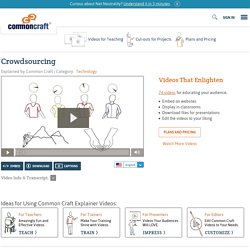
Today, we have a new option - we can ask a crowd of motivated strangers from around the world for help. Neville was faced with a challenge. He was working on the world’s most difficult crossword puzzle and had a deadline one month away. Web Search Strategies Explained by Common Craft. The Web may seem like a vast ocean when it comes to finding something you need. Thankfully, search engines can help turn oceans of information into small pools that make finding information easier. Before we dive in, let’s talk a bit about how search works on the Web.
Website Evaluation Explained by Common Craft (VIDEO) Finding accurate and useful information on the Web can be frustrating. With so many websites, it’s difficult to know what is trustworthy and factual. To solve this problem, you need think like an editor. Google Better Searches. Rhetological Fallacies. Bookmarking rubric. Validating rubric.